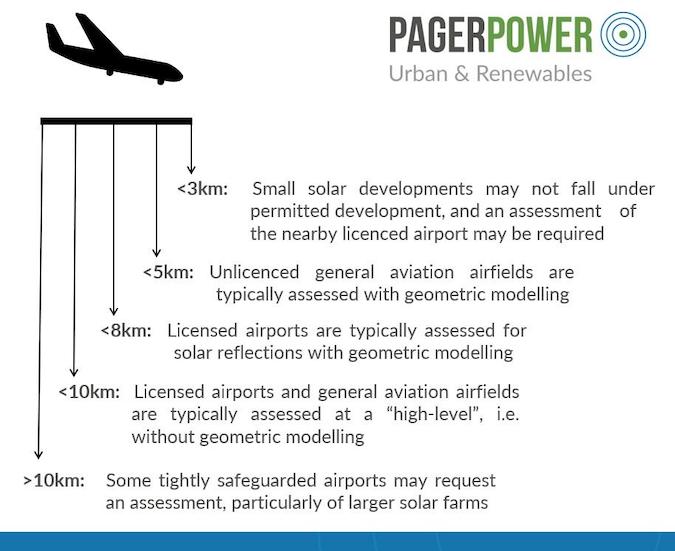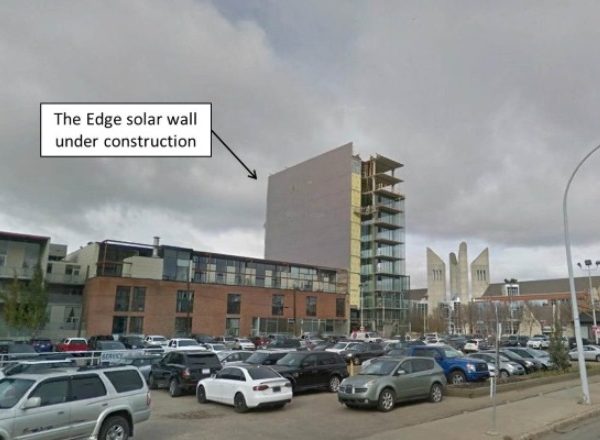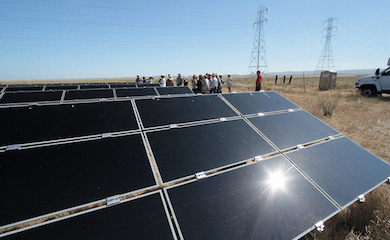With the growing presence of solar PV developments, both on open land and upon rooftops, the co-existence of solar and airports in proximity to one another has become commonplace. In this brief article we examine the distances at which an assessment of potential glint and glare might be required for a solar development.
Why is assessing potential glint and glare important for aviation?
Solar panels are designed to absorb light rather than reflect it. Reflected light is wasted energy after all. However, solar reflections are possible (as solar panels are not 100% efficient) and if these are experienced by the pilot of an aircraft, or an air traffic controller within an ATC tower, safeguarding concerns can be raised.
As such, a typical assessment of an airport or airfield will include the final sections of the approach paths and the air traffic control tower, if one is present. Other aviation activity may be requested for assessment by the safeguarding team, including back-up ATC towers, visual circuits, or helicopter approach paths.
An assessment of glint and glare is a common requirement for solar developments in proximity to an aerodrome. But how close is close enough? Let’s break down some common distances and associated assessment requirements, both within the UK and overseas.
Relative distances in the UK
There is no legal or regulatory framework which details the distances at which a solar development should be assessed with respect to glint and glare upon aviation activity.
Generally, the further a development is from an aerodrome, the less potential there is for significant reflections or safeguarding concerns. With increased distance the intensity of reflections decreases; and for air traffic control towers, intervening terrain is more likely to obstruct views of reflecting areas. The greatest scrutiny is paid to developments on or just neighbouring airports and airfields.
The diagram below lays out distances of a solar development from an aerodrome, and the typical associated glint and glare assessment requirements for licenced aerodrome (both civil airports and military airbases) and general aviation airfields. Pager Power’s understanding of these requirements has developed from consultation with aviation stakeholders and past project experience.
Figure 1: Relative distances and typical assessment requirements.
While the above is generally true for most developments, individual planning authorities may have their own preferences or expectations on what should be assessed, and these can be more or less strict than the distances above. In a similar vein, individual airports may may have a position on nearby solar, with requests for assessment at different distances. Consultation is often the most efficient way to understand requirements before planning.
Overview of relative distances in other countries
The Republic of Ireland has “solar safeguarding zones”, areas around particular airports and helipads in which rooftop solar projects should be assessed with respect to any aerodrome whose safeguarding zone the development falls within.
South Africa’s Civil Aviation Authority has previously released guidance stating: “A Glint & Glare Assessment will be required as soon as the proposed site is located on the extended runway centreline within the … Approach Surface, Take-Off Climb Surface & Departure Surface, and within 3km radius around an Aerodrome/helistop”. This guidance however has since been removed without a superseding position at of the time of writing.
In Saudia Arabia, where solar farms can span kilometres, aerodromes across the country can be required for assessment, with airports tens of kilometres away being taken forward for geometric modelling in some cases.
How Pager Power can assist
Pager Power is a dedicated consultancy firm with many years of experience in assessments of aviation safeguarding and glint and glare, with over 1,400 glint and glare assessments undertaken. If you would like advice or require a technical assessment for your project, please do not hesitate to get in touch.




